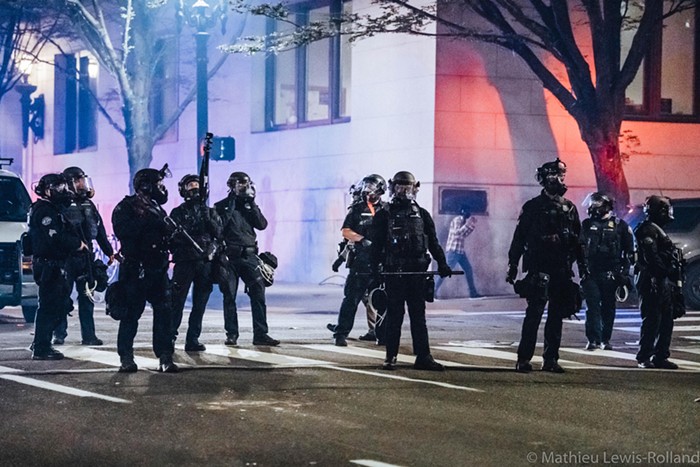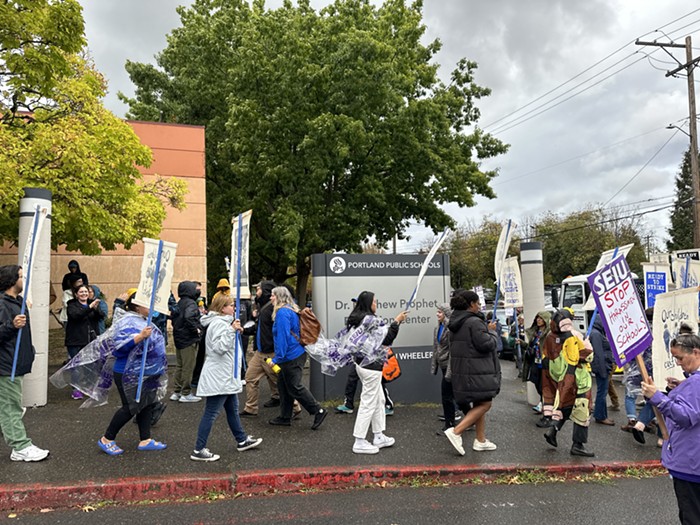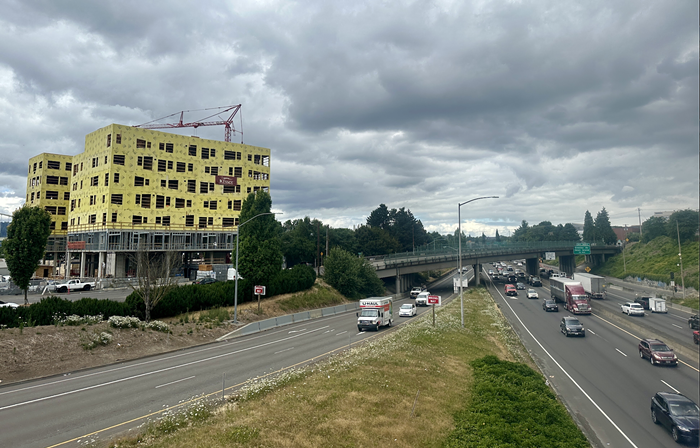A detox worker at the Hooper Center's sobering station performs his hourly check on the forty-ish methadone user in the women's holding area. He rouses Linda, who is sleeping sprawled on the cell's concrete floor. "Leave me alone," she rasps back. Linda has been here almost eight hours, since about noon. She, along with a drunken man passed out in the first cell, are the center's only clients when I arrive at 8 p.m. Friday night.
The Hooper Center, located just north of Burnside on Martin Luther King, houses several drug and alcohol programs. Its most notorious service--and the one Portlanders are most likely to have come into contact with--is the sobering station: a multi-celled, medically monitored holding area where people found publicly intoxicated can sober up safely, usually staying at the facility from four to eight hours.
In addition, the Hooper Center has been held up as a national model--a system that other cities plan on duplicating. However, the callous nature with which some of the employees treat their intoxicated clients is certainly not a virtue other centers would want to copy.
WHERE THE DRUNK PEOPLE ARE
Founded in 1971, after the Oregon legislature defined alcoholism as a disease and not a responsibility of the criminal law system, the David P. Hooper Detoxification Center was named after the last man to die of alcoholism in the old city jail. The non-profit agency that would eventually become Central City Concern took over the facility in 1982. The Hooper Center also houses a 54-bed, longer-term detoxification program.
Central City Concern also operates the CHIERS (Central City Concern Hooper Inebriate Emergency Response Service) vans, which are intended to locate and pick up at-risk inebriates from Portland's streets and take them to the sobering station.
According to CCC's Ed Blackburn, a former on-site manager who now oversees the Hooper Center, the sobering station admitted more than 13,000 people last year. Of these, about 3,800 were brought in by CHIERS. The majority of patients are taken to Hooper by police officers.
Oregon law (ORS 430.399) requires police to transport any at-risk, publicly intoxicated person to "an appropriate treatment facility." Without Hooper, these people would tax already-overburdened jails and emergency rooms.
The other sobering stations in Oregon--in Eugene and Medford--were modeled on the Hooper facility, says Steve Brummett, the program director at Medford's facility. Seattle also modeled its facility on Hooper.
Bob Bakken, from the Hennepin County, Minnesota health department (which serves Minneapolis), heads a committee whose goal is to establish a sobering station facility like Hooper. At present, Minneapolis only has expensive, two day detox services available, which are in high demand; the city's public inebriates usually end up in its overtaxed ERs.
INSIDE THE DRUNK TANK
I have driven past the Center two times already. The building looks like a warehouse and is hidden by a large parking lot, where I park at 7:50 pm, down a cup of coffee, and give myself a pep talk. Two former Hooper employees have told me they had seen staff members mistreat clients (at-risk inebriates) and misuse facilities. In order to investigate these allegations, I am posing as an EMT student researching an extra-credit project.
Karen, an EMT, worked at the Hooper Center only three days before she quit in disgust. "I felt the other employees didn't treat the clients with much respect." She witnessed an employee who had been having a bad day make threatening gestures and taunt a drunken man waiting quietly to be admitted. Other workers failed to call him on this inappropriate behavior.
Jane, another EMT, worked at Hooper for one-and-a-half years before she left, also after an incident that left her disgusted with certain employees' treatment of clients. Shortly before leaving, she says, the CHIERS van picked up two men whom they had seen frequently. The woman driving the van said she was "sick of picking them up," drove out to Jantzen Beach, told them to get out, and then drove away. Ultimately, after several weeks of investigation, the driver was fired.
The Hooper Center has three main holding cells and four very small, solitary "security rooms," meant only for violent or suicidal ("escalated") clients. "They would put dangerous patients in there," Jane says, "but would also threaten patients with whom they were angry or annoyed [with confinement to a solitary room]."
She says that CHIERS van drivers would often hang out in the center or "go sit in a park and read" for hours, instead of patrolling downtown Portland looking for at-risk public inebriates who might need the sobering station's services.
Jane claims the environment at Hooper tolerates this type of behavior and that new employees who try to change things are criticized by a contingency of conservative, longer-term employees. "They provide a great service," she says, "but some people don't take their jobs seriously, and it's unfortunate."
Jane also claims that employees--especially non-medical "detox workers"--are inadequately trained and under-prepared for the stress of the sobering station environment, and sometimes lash out at clients as a result. Out-of-touch management, she says, is largely to blame.
I was at Hooper for only four hours--eight to midnight--but during that time I witnessed many of the behaviors Karen and Jane reported. I saw employees try to provoke and humiliate clients. One young man was threatened several times with solitary confinement as punishment, and eventually confined.
The CHIERS staff on duty responded to several calls, but otherwise remained at the Center playing video games, Scrabble, or chatting; they were not doing what they were paid to do--patrolling downtown Portland on a Friday night.
LINDA AND MIKE
Linda, now fully awake, approaches the panoptic observation room, where I sit talking with Mike. He is a detox worker whose role is to observe clients and answer their questions and requests. Linda demands to know the time, her voice a sharp whine. Mike shrugs wearily when she refuses to accept that it's 8 p.m.; she'll ask the same question, just as insistently, five minutes later. Linda is a regular at the Hooper Center.
Mike has been working here four months, and has already adopted the self-consciously-weathering-the-storm attitude I find characteristic of the Hooper Center's staff.
Approaching the observation window again, Linda asks for a cup of coffee. Mike just laughs--water, soup, and crackers only, are a patient's privilege.
"I was just sleeping where someone pissed," Linda says, "and it got all over me."
"That's pretty gross, Linda," Mike says, and turns back to his notebook. Linda storms over to the table, where she sits for the next few hours, sipping water and intermittently moaning.
"MOTHERFUCKING" SCOTT
A few more regulars are brought in, and things are quiet until Scott, our first real Friday night casualty, is escorted into the facility by a police officer. It's a little after nine. Scott is an obnoxious, 18-year-old, white b-boy poseur, which immediately irks detox worker Mike, whose suburban, Old-Navy-baseball-cap style is the norm among staff. Scott has bad skin and straggly brown hair, and wears an oversized striped polo shirt, baggy jeans, and white Nikes. He peppers his melodramatic slang with a "motherfucker" between every few words.
"These motherfuckers wanna break my nose!" Scott yells, alarmed, as he's dragged into the holding cell, "motherfucker"-ing his attendants frequently and greeting the other two drunks occupying the room in the same way.
"You think that's the worst room in the house?" EMT Brandon warns, "You keep pushin' me."
[He was threatening to put Scott in a security room. These solitary cells are meant for violent, "escalated" clients who endanger other patients or themselves, and are not intended for punitive use, according to Blackburn.]
Detox worker Mike sits back and watches Scott, who continues to insist, in his loud, obscenity-laden patois that has already become familiar, that he's not only not drunk, but that he is in fact totally sober and needs to be released because he really, really has to be somewhere at ten.
When it becomes clear to Scott, minutes later, that his insistence is futile, he shouts for awhile at the other clients and, when he tires of their mumbled responses, alternates between pacing the cell perimeter and sitting at the table, looking at his hands.
Scott's display of nervous energy both amuses and disgusts Mike, the detox worker, who tells EMT Brandon, "This one's crazy. This one's cuckoo for Cocoa Puffs. Are you cuckoo for Cocoa Puffs, Scott?"
Scott flips Mike off and continues ranting and pacing, then asks when he can leave.
"We keep people here for three days, Scott," Mike lies, laughing.
"Fuck you," Scott replies, and keeps pacing.
Later, when EMT Brandon is in the holding cell responding to a patient's complaint of chest pain, Scott stands nearby repeating, "This motherfucker's having a heart attack," until, livid, Brandon spits out, "If you don't shut up, I'll put you in a room by yourself."
Scott backs off, but returns to the observation window to pester detox worker Mike, asking inane questions and demanding his "right" to take a sobriety test.
"You don't have any rights, Scott," EMT Brandon says, referring to the legal status of a Hooper patient, who is under a civil hold and, essentially, doesn't have any rights.
Later, Scott asks me what time it is and I try to indicate the clock above my head with eyeball gestures, lest Mike and Brandon--who unabashedly despise him--notice, and think Scott and I are in cahoots.
Eventually, Scott is taken to a security room, after EMT Brandon yells at him again: "You're being a smartass and it's pissing me off!" [Scott was allegedly threatening other patients; I didn't see this, but I wasn't observing him all the time.]
Once in the tiny cell, he huddles next to the door and ceases cussing and slanging, finally subdued.
Around 11, the CHIERS van brings in a well-dressed woman in her forties who is very drunk and obviously very ashamed to be there. When she responds, "Shut your fuckin' mouth," to a CHIERS driver's mean-spirited comment that she should "think about an intervention," he further humiliates her, scolding her like a child for swearing. Seconds later, the driver announces to other staff members, "I like it when they're really fucked up, because there isn't any gray area."
NO PLACE IN HEAVEN
Not long before she is discharged, Linda, the methadone user, confronts me through the observation window. "Are you going to work here?" she demands, "I hope you don't work here." Linda indicates detox worker Mike and EMT Brandon as she goes on: "There's no place in heaven for people like these."
Mike shrugs at me with an unwelcome "We're teammates now, get used to it" look.
Although Linda's doped-up conclusion is melodramatic, both Mike, the detox worker who was observing, and Brandon, the EMT, made it clear they found her and the other clients' behavior disgusting. Mike, especially, did not hesitate to respond with mockery, taunts, and attempted humiliation when patients acted out. Brandon--who, as EMT, was the official shift supervisor--spoke less often, but he also failed to confront Mike about his inappropriate behavior.
I stayed in the observation area where Mike and Brandon were stationed for the majority of my four-hour stint at Hooper. When I did observe the admitting process, I found the other employees treating clients respectfully, if coldly, and without contempt or sarcasm.
Kathy, a detox worker who has worked at the Hooper Center for more than six years, warned me about the job's demands. Though she had been in the office and admitting area all night, she seemed to intuit what I had witnessed in the observation room, saying, "Some people don't last here because they think they have the power to control and punish people who are inebriated--they hold [clients] responsible for their actions while drunk."
Mike, the detox worker, had been at Hooper only four months, but EMT Brandon's two-year-plus tenure at the center belied Kathy's confident claim that the staff would correct or remove anyone who treated clients with contempt. "You have to be non-judgmental to work here," she says.
AN EXTREMELY DIFFICULT POPULATION
I confronted Ed Blackburn from Central City Concern with the allegations and what I had observed.
Blackburn says that the CHIERS van drivers who were hanging out at the Center may have been out patrolling earlier, say from six to eight, and "If they weren't seeing many people, they may have decided to come in and save wear-and-tear and gas." He did not explain why they weren't patrolling later on a Friday night.
Blackburn says he is concerned about the possibility that solitary confinement is used as punishment. "We have had no complaints, from any staff that I know of, that security rooms are used in a punitive fashion against a client that hasn't done anything to indicate that they're escalated or dangerous," Blackburn says.
Blackburn acknowledged the fact that the way obnoxious Scott had been threatened several times with solitary confinement made it seem like the cell was used punitively. However, he says, it's possible that an employee knew Scott, knew his behavior patterns, and predicted that he would become violent. "I'd want to get the staff member's side of the story about this client," he says.
"The things you're describing to me"--the ways in which Linda and others were mistreated--"are things that I know can happen," he acknowledges. "I think [the Hooper staff] deals with an extremely difficult population. When someone gets in your face and yells and screams and spits on you, and you get about three or four of those in a night, [you might act out]."
CHILDREN VS. DRUNKS
A trauma nurse who has worked in Portland emergency rooms for 12 years says that Hooper's services are essential, but calls it a "band-aid on an open, gaping wound." Portland's addiction-recovery resources are underdeveloped and under-funded.
Blackburn says that some Hooper staff members have been through anger- and stress-management workshops, but that employees need more support.
"We need to strive to support the staff--this is never-ending" he says. "It would be good if we had the resources to provide more coping mechanisms for people to deal with this stuff."
Kevin Norton, the supervisor of a detox facility in Boston, MA, blames the social stigma attached to substance abuse for legislators' readiness to cut programs like Hooper's.
Human services get cut first, he says, and substance-abuse programs are among the first of those. Special education and children's services are affected last, if at all. Legislators know that it is political suicide to take taxpayers' hard-earned money from smiling innocents-- children and the developmentally disabled--to fund drug and alcohol recovery programs, which serve those who are seen as vicious and criminal.
"It's not uncommon to hear, 'Hey, [alcohol and drug addicted individuals] are lucky to get anything.' The stigma is huge, and keeps these programs down," Norton says. As a culture, we remain stubbornly Protestant, unwilling to forgive substance abusers for past choices that we find morally reprehensible.
The newly Republican Congress will no doubt make funding for substance-abuse programs even scarcer. As a model for sobering station facilities throughout the country, Hooper's services will undoubtedly be scrutinized. Its excellent medical record (the sobering station has seen only a handful of deaths out of over 100,000 admissions since 1991) could be eclipsed by only a few reports of client mistreatment.
Blackburn bemoans the budget shortfalls. "We are in an age of limited resources," he says, "and no one's giving us any money." Such acute funding shortages threaten to undermine a valuable Portland resource and hamper managements efforts for improvement.
Blackburn says that the sobering station supervisor is investigating some of the incidents I witnessed that Friday night.


















